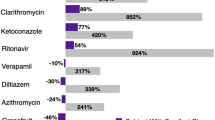Summary
Six female rabbits were given 20 mg/kg cyclophosphamide (containing 100 μCi [3H-chloroethyl]-cyclophosphamide) alone or 1 h following 100 mg/kg cimetidine. Serial plasma and urine specimens were collected and levels of cyclophosphamide and its metabolites (4-hydroxycyclophosphamide, 4-ketocyclophosphamide, phosphoramide mustard, and carboxyphosphamide) were measured. 4-Ketocyclophosphamide was the major metabolite present in rabbit plasma and urine, with lesser amounts of 4-hydroxycyclophosphamide, carboxyphosphamide, and phosphoramide mustard also being identified. Cimetidine pretreatment resulted in prolongation of cyclophosphamide's half-life from 24.3±7.3 to 33.5±9.5 min (mean ± SD;P=0.036) but did not significantly alter the AUC0–8 h for the latter drug. Cimetidine pretreatment resulted in a significantly greater AUC0–8 h for 4-hydroxycyclophosphamide (189.4±77 vs 364.6±126.7 μmol min/l−1;P=0.016) as compared with control values. A higher AUC0–8 h value for phosphoramide mustard (53.7±69.2 vs 95.7±34.7 μmol min/l−1) was also observed after cimetidine dosing but the difference was not significant (P=0.21). Kinetics of 4-ketocyclophosphamide and carboxyphosphamide were not significantly affected by cimetidine treatment. Cimetidine was added to hepatic microsomes isolated from phenobarbital-treated rabbits; it did not inhibit cyclophosphamide's metabolism in vitro, suggesting that its in vivo effect may be mediated through mechanisms other than cytochrome P-450 inhibition. Cimetidine pretreatment increases exposure to cyclophosphamide and its major activated metabolite, 4-hydroxycyclophosphamide. Potentiation rather than inhibition of cyclophosphamide's pharmacodynamic effect is to be predicted when cimetidine is given concomitantly with the former. Alterations in hepatic blood flow or mechanisms other than microsomal inhibition by cimetidine may explain this potentiation.
Similar content being viewed by others
References
Alberts DS, Peng YM, Chen HS, Struck RF (1978) Effect of phenobarbital on plasma levels of cyclophosphamide and its metabolites in the mouse. Br J Cancer 38: 316
Bakke JE, Feil VJ, Fjelstul CE, Thacker EJ (1972) Metabolism of cyclophosphamide by sheep. J Agric Food Chem 20: 384
Borch RF, Hoye TR, Swanson TA (1984) In situ preparation and fate ofcis-4-hydroxycyclophosphamide and aldophosphamide. J Med Chem 27: 490
Brock N, Hohorst H-J (1977) The problem of specificity and selectivity of alkylating cytostatics: studies onN-2-chloroethylamide-oxazaphosphorines. Z Krebforsch 88: 185
Brock N, Stekar J, Pohl J, Niemeyer U, Scheffler G (1979) Acrolein, the causative factor of urotoxic side-effects of cyclophosphamide, ifosfamide, trofosfamide, and sufosfamide. Arzneimittelforschung 29: 659
Cox PJ (1979) Cyclophosphamide cystitis-idendification of acrolein as the causative agent. Biochem Pharmacol 28: 2045
Cox PJ, Phillips BJ, Thomas P (1975) The enzymatic basis of the selective action of cyclophosphamide. Cancer Res 35: 3755
Domeyer BE, Sladek NE (1980) Kinetics of cyclophosphamide biotransformation in vivo. Cancer Res 40: 174
Dorr RT, Soble MJ, Alberts DS (1986) Interaction of cimetidine but not ranitidine with cyclophosphamide in mice. Cancer Res 46: 1795
Feely J, Wilkinson GR, Wood AJJ (1981) Reduction of liver blood flow and propranolol metabolism by cimetidine. N Engl J Med 304: 692
Fenselau C, Kan MN, Rao SS, Myles A, Friedman OM, Colvin M (1977) Identification of aldophosphamide as a metabolite of cyclophosphamide in vitro and in vivo in humans. Cancer Res 37: 2538
Fenselau C, Lehman JP, Myles A, Brandt J, Yost GS, Friedman OM, Colvin OM (1982) Iminocyclophosphamide as a chemically reactive metabolite of cyclophosphamide. Drug Metab Dispos 10: 636
Jao JY, Jusko WJ, Cohen JL (1972) Phenobarbital effects on cyclophosphamide pharmacokinetics in man. Cancer Res 32: 2761
Kevon CH, Kirk MC, Struck RF, Borch RF (1987) Spectroscopic detection of iminocyclophosphamide and its possible role in cyclophosphamide metabolism. J Med Chem 30: 1110
Lowry OH, Rosebrough NJ, Farr AL, Randall RJ (1951) Protein measurement with the folin phenol reagent. J Biol Chem 193: 265
Marinello AJ, Bansal SK, Paul B, Koser PL, Love J, Struck RF, Gurtoo HL (1984) Metabolism and binding of cyclophosphamide and its metabolite acrolein to rat hepatic microsomal cytochrome P-450. Cancer Res 44: 4615
Omura T, Sato R (1964) The carbon monoxide-binding pigment of liver microsomes: II. Solubilization, purification and properties. J Biol Chem 239: 2379
Sladek NE (1972) Therapeutic efficacy of cyclophosphamide as a function of its metabolism. Cancer Res 32: 535
Sladek NE (1988) Metabolism of oxazaphosphorines. Pharmacol Ther 37: 301
Struck RF (1974) Isolation and identification of a stabilized derivative of aldophosphamide, a major metabolite of cyclophosphamide. Cancer Res 34: 2933
Struck RF, Alberts DS (1984) Blood levels of alkylating metabolites of cyclophosphamide in the mouse after IV or oral administration. Cancer Treat Rep 68: 765
Struck RF, Kirk MC, Mellett LB, Dareer SE, Hill DL (1971) Urinary metabolites of the antitumor agent cyclophosphamide. Mol Pharmacol 7: 519
Wang PP, Beaune P, Kaminsky LS, Dannan GA, Kadlubar FF, Larrey D, Guengerich FP (1983) Purification and characterization of six cytochrome P-450 isozymes from human liver microsomes. Biochemistry 22: 5375
Author information
Authors and Affiliations
Additional information
Supported in part by the Department of Veteran Affairs and grant CA-49186 from the National Institutes of Health (NIH)
Department of Clinical Pharmacology, Sun Yat-sen University of Medical Sciences, Guangzhou, People's Republic of China
Rights and permissions
About this article
Cite this article
Anthony, L.B., Long, Qc., Struck, R.F. et al. The effect of cimetidine on cyclophosphamide metabolism in rabbits. Cancer Chemother. Pharmacol. 27, 125–130 (1990). https://doi.org/10.1007/BF00689096
Issue Date:
DOI: https://doi.org/10.1007/BF00689096




